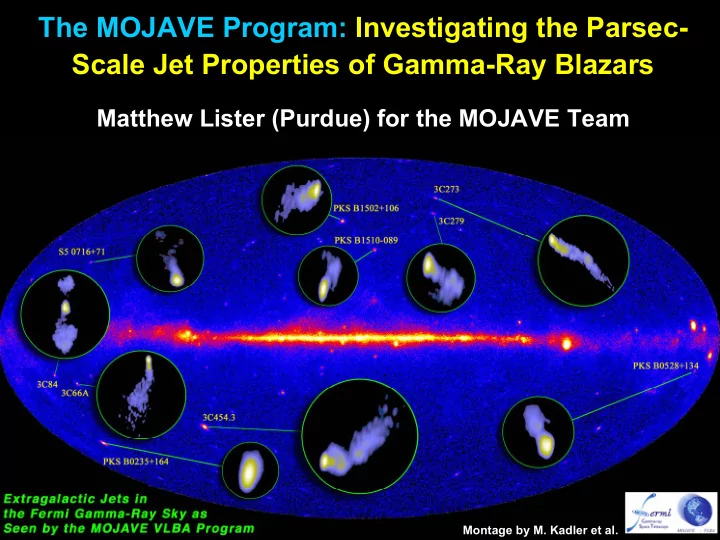

The MOJAVE Program: Investigating the Parsec- Scale Jet Properties of Gamma-Ray Blazars Matthew Lister (Purdue) for the MOJAVE Team Montage by M. Kadler et al.
M onitoring MOJAVE Collaboration Collaboration MOJAVE O f � M. Lister (P.I.), N. Cooper B. Hogan, S. Kuchibhotla, T. J ets in Hovatta (Purdue) � T. Arshakian, C.S. Chang, L. Fuhrmann, Y. Kovalev, A. A ctive Galaxies with Lobanov, A. Pushkarev, T. Savolainen, J. A. Zensus (Max Planck Inst. for Radioastronomy) � M. and H. Aller (Michigan) V LBA � M. Cohen (Caltech) E xperiments � D. Homan (Denison) � M. Kadler (U. Erlangen-Bamberg) � K. Kellermann (NRAO) Very Long Baseline Array � Y. Kovalev (ASC Lebedev) � E. Ros (Valencia) � N. Gehrels, J. McEnery, R. Sambruna, J. Tueller (GSFC) We thank the LAT team for providing preliminary 1 st LAT catalog data The MOJAVE Program is supported under NASA Fermi Grant NNX08AV67G and NSF grant 0406923-AST.
Project description: Project description: Studying the long term structural evolution of pc-scale • jets in over 250 AGN � mas-resolution full polarization images � parallel studies of kpc x-ray and radio jets Complete AGN sample selected on the basis of • compact, beamed radio emission (blazars) � being extended to encompass new bright gamma-ray AGN http://www.physics.purdue.edu/MOJAVE Lister et al., 2009, AJ, 137, 3718
Recent findings (526 features in 127 AGN jets): Recent findings (526 features in 127 AGN jets): � Superluminal motions are the norm in radio-selected blazar jets typically ~10c, broad range up to 50 c: (PKS 0805-077) – motions are related to underlying flow – caveat: in rare cases stationary bright features are seen near the base of the jet – � Bright features within a single jet typically move with similar characteristic speed Lister et al., 2009, AJ, (arXiv 0909.5100)
Recent findings: Recent findings: � Over 1/3 of bright jet features are accelerating – creates the illusion of ‘bent jets’ in single epoch VLBA images – changes in speed are more common than changes in direction � Positive (speeding up) accelerations are more prevalent close to the base of the jet � flows are still becoming organized on pc scales 3C 273 Homan et al., 2009, ApJ, (arXiv 0909.5102)
Recent findings: Recent findings: Filled circles = VLBI Open circles = single-dish Kovalev et al. 2009, ApJ 696, L17 (see poster P1-19 by Kovalev et al. ) Good correlation between Fermi LAT γ -ray photon flux and the quasi-simultaneously measured compact radio flux density.
Fermi+VLBA=Killer Combination for Blazar Science Fermi+VLBA=Killer Combination for Blazar Science A C Gamma-ray Flux ~75% of MOJAVE-1 is LAT- Newly added detected AGN from 1 st LAT Catalog LAT data not yet available D Preliminary! B Non-simultaneous 15 GHZ VLBA Flux Density [Jy]
What makes an AGN γ γ – –ray bright? ray bright? What makes an AGN Complex combination of: 1. Preferred viewing angle 2. High jet Lorentz factor 3. High current activity state 4. High-peaked spectral energy distribution
Apparent Jet Opening Angles Apparent Jet Opening Angles � 3month MOJAVE-LAT generally have broader MOJAVE/LAT/TeV apparent opening HBL 1424+240 angles than non-LAT � Overall intrinsic opening angle distributions are similar � The bright LAT blazar Poster jets are typically P1-8 viewed closer to the line of sight Pushkarev et al., arXiv/0910.1813
Doppler Factors Doppler Factors Shaded: QSO Unshaded = BL Lacs � MOJAVE-LAT AGN jets have significantly higher Savolainen et al., Poster P1-32 Doppler factors than MOJAVE non-LAT Variability Doppler factor � Constrains viewing angle: non-LAT θ < sin -1 ( δ -1 ) LAT Kuchibhotla et al., in prep. Preliminary 1 st � Anisotropy of gamma-ray LAT Catalog emission may also influence viewing angle range – see Savolainen et al. poster P1-32 Equipartition Lorentz factor
Apparent Jet Speeds Apparent Jet Speeds Preliminary 1 st LAT Catalog � Strong correlation between apparent speed and radio luminosity � LAT has now detected nearly every fast jet in the MOJAVE sample! Lister et al. 2009, AJ, arXiv 0909.5100 Kadler et al., Poster P1-43 Compact radio luminosity [W/Hz]
Apparent Jet Speeds Apparent Jet Speeds Preliminary 1 st LAT Catalog Kadler et al., Poster P1-43 Gamma-ray luminosity [erg/s]
Jet Activity States Jet Activity States � At any given time, only the energized portion of a broader jet is visible � Activity states of AGN jets evolve over time Stacked image: 1995-2009 long quiescent periods of no blob ejection – are seen new blobs ejected at new position angles – only 30% of the 3 month LAT AGN were – detected by EGRET � Are changes in pc-radio jet morphology reflected in the gamma- ray activity? YES – see poster by Jorstad et al. Image from March 1996 Recent image: June 2009 Lister et al., 2009, AJ, 137, 3718
1308+326: BL Lac at z = 1 40 pc
MOJAVE complete sample activity in 2008 Activity index in radio band: V=(S 2008 -S 1999-2007 )/S 1999-2009 Fermi LAT MOJAVE non-detected non-LAT Statistical conclusions: 1. MOJAVE-LAT AGN are in a high activity state, both in total intensity, and polarization (Kovalev P1-19, Hovatta P1-36, Aller P1-3) 2. Flares in radio and γ -ray domain happen within a typical apparent MOJAVE Fermi LAT Black = γ -variable LAT detected time separation of a few months Does the jet beaming factor change with activity state? Kovalev et al., 2009, ApJ, (arXiv 0902.2085)
MOJAVE- -LAT Summary LAT Summary MOJAVE � Blazar gamma-ray emission originates on pc-scales in relativistically moving plasma – likely shock fronts. � Compared to other radio blazars, LAT-detected jets are: – faster and more highly beamed – more highly polarized and in a high active state in the radio � SED peak location plays a key role in BL Lac LAT detections (see posters P1-21, P1-42, P1-43 ) � VLBA+Fermi is a fantastic tool for nailing down where the gamma-rays are being produced within the jet.
Recommend
More recommend